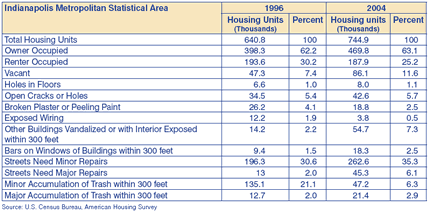Inside the Data Center
American Housing Survey
According to the Census Bureau’s American Housing Survey for the Indianapolis Metropolitan Area 2004, housing and neighborhood quality data for all housing units show that, since 1996, housing and neighborhood quality have declined slightly.
The number of housing units is up from 640,800 in 1996 to 744,900 in 2004, a 16.2 percent increase. The percent of owner-occupied homes increased slightly from 62.2 to 63.1 percent while rentership declined from 30.2 to 25.2 percent. Overall, the vacancy rate increased from 7.4 to 11.6 percent.
With regard to selected deficiencies of housing units, the number of homes with holes in the floors or with open cracks or holes in the interior increased slightly. The number of homes with broken plaster or peeling paint declined, as did the number of those with exposed electrical wiring.
There was a sharp increase in the number of houses with one or more vandalized buildings or buildings with an exposed interior within 300 feet, as well as a modest increase in buildings within 300 feet that have bars on the windows.
Results for street conditions were mixed. The need for both minor and major repairs increased. Reports of minor accumulations of trash, litter or junk on streets or property declined drastically, while there was a slight increase in the report of major accumulations of trash, litter or junk (see Table 1).
Table 1: American Housing Survey, 1996 to 2004
To access the full report (as well as the 1996 report), visit the American Housing Survey Web page at www2.census.gov/library/publications/1997/demo/h170_96-50.pdf.
Indiana Business Diversity
DiversityBusiness.com, a leading multicultural business resource portal that links large organizational buyers and multicultural business owners, publishes an annual list of the nation’s top diversity-owned and small businesses. Minority- and women-owned business and small-business owners vote for the companies they believe provide the best support to the diversity business community. Table 2 shows the top five Indiana businesses for 2004 in each category.
Table 2: Top Five Small and Diversity-Owned Businesses, 2004
ACS Online Guide
The Census Bureau has released an online guide about the newest data products, including the first in a series of analytic reports that are being introduced starting with the August 30th data release for the 2004 American Community Survey (ACS). The guide is aimed at both experienced ACS data users and those new to the ACS, including tools to help data users quickly locate the geographic areas in a state for which 2004 ACS estimates will be published, locate and compare the changes between the new base table(s) (also known as detailed tables) and base tables from past years, and locate all the base tables for a specific topic.
For each new base table, there is also a link to the table layout so the user can see exactly how the table will appear in American FactFinder.
In addition to the tools, there are several useful documents that should be of interest to both new and experienced ACS data users. These documents are in a hyperlink list on the main page of the Guide to the ACS Data Products and may be found at www.census.gov/programs-surveys/acs/guidance/handbooks.html.
Frank Wilmot, State Data Center Coordinator
Indiana State Library


